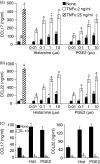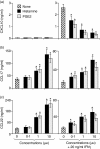Histamine and prostaglandin E up-regulate the production of Th2-attracting chemokines (CCL17 and CCL22) and down-regulate IFN-gamma-induced CXCL10 production by immature human dendritic cells
- PMID: 16556265
- PMCID: PMC1782249
- DOI: 10.1111/j.1365-2567.2006.02326.x
Histamine and prostaglandin E up-regulate the production of Th2-attracting chemokines (CCL17 and CCL22) and down-regulate IFN-gamma-induced CXCL10 production by immature human dendritic cells
Abstract
Effector memory T helper 2 (Th2) cells that accumulate in target organs (i.e. skin or bronchial mucosa) have a central role in the pathogenesis of allergic disorders. To date, the factors that selectively trigger local production of Th2-attracting chemokines remain poorly understood. In mucosa, at the sites of allergen entry, immature dendritic cells (DC) are in close contact with mast cells. Histamine and prostaglandin E2 (PGE2) are two mediators released by allergen-activated mast cells that favour the polarization of maturing DC into Th2-polarizing cells. We analysed here the effects of histamine and PGE2 on the prototypic, Th2-(CCL17, CCL22) versus Th1-(CXCL10) chemokine production by human DC. We report that histamine and PGE2 dose-dependently up-regulate CCL17 and CCL22 by monocyte-derived immature DC. These effects were potentiated by tumour necrosis factor-alpha, still observed in the presence of the Th1-cytokine interferon-gamma (IFN-gamma) and abolished by the immunomodulatory cytokine interleukin-10. In addition, histamine and PGE2 down-regulated IFN-gamma-induced CXCL10 production by monocyte-derived DC. These properties of histamine and PGE2 were observed at the transcriptional level and were mediated mainly through H2 receptors for histamine and through EP2 and EP4 receptors for PGE2. Finally, histamine and PGE2 also up-regulated CCL17 and CCL22 and decreased IFN-gamma-induced CXCL10 production by purified human myeloid DC. In conclusion, these data show that, in addition to polarizing DC into mature cells that promote naïve T-cell differentiation into Th2 cells, histamine and PGE2 may act on immature DC to trigger local Th2 cell recruitment through a selective control of Th1/Th2-attracting chemokine production, thereby contributing to maintain a microenvironment favourable to persistent immunoglobulin E synthesis.
Figures







Similar articles
-
Virus overrides the propensity of human CD40L-activated plasmacytoid dendritic cells to produce Th2 mediators through synergistic induction of IFN-{gamma} and Th1 chemokine production.J Leukoc Biol. 2005 Oct;78(4):954-66. doi: 10.1189/jlb.0704383. Epub 2005 Aug 4. J Leukoc Biol. 2005. PMID: 16081597
-
Monocyte-derived dendritic cells exposed to Der p 1 allergen enhance the recruitment of Th2 cells: major involvement of the chemokines TARC/CCL17 and MDC/CCL22.Eur Cytokine Netw. 2003 Oct-Dec;14(4):219-28. Eur Cytokine Netw. 2003. PMID: 14715413
-
Differential production of Th1- and Th2-type chemokines by mouse Langerhans cells and splenic dendritic cells.J Invest Dermatol. 2005 Feb;124(2):343-50. doi: 10.1111/j.0022-202X.2004.23607.x. J Invest Dermatol. 2005. PMID: 15675953
-
Differential migration behavior and chemokine production by myeloid and plasmacytoid dendritic cells.Hum Immunol. 2002 Dec;63(12):1164-71. doi: 10.1016/s0198-8859(02)00755-3. Hum Immunol. 2002. PMID: 12480260 Review.
-
The role of prostaglandin E2 receptor signaling of dendritic cells in rheumatoid arthritis.Int Immunopharmacol. 2014 Nov;23(1):163-9. doi: 10.1016/j.intimp.2014.08.024. Epub 2014 Sep 4. Int Immunopharmacol. 2014. PMID: 25196430 Review.
Cited by
-
Treatment of allergic asthma: modulation of Th2 cells and their responses.Respir Res. 2011 Aug 25;12(1):114. doi: 10.1186/1465-9921-12-114. Respir Res. 2011. PMID: 21867534 Free PMC article. Review.
-
H1 Antihistamines-Promising Candidates for Repurposing in the Context of the Development of New Therapeutic Approaches to Cancer Treatment.Cancers (Basel). 2024 Dec 20;16(24):4253. doi: 10.3390/cancers16244253. Cancers (Basel). 2024. PMID: 39766152 Free PMC article. Review.
-
T lymphocytes as a target of histamine action.Arch Med Sci. 2012 Feb 29;8(1):154-61. doi: 10.5114/aoms.2012.27295. Arch Med Sci. 2012. PMID: 22457689 Free PMC article.
-
Is obesity associated with an increased risk for airway hyperresponsiveness and development of asthma?Allergy Asthma Clin Immunol. 2008 Jun 15;4(2):51-8. doi: 10.1186/1710-1492-4-2-51. Epub 2008 Jun 15. Allergy Asthma Clin Immunol. 2008. PMID: 20525125 Free PMC article.
-
Mast cells in allergic asthma and beyond.Yonsei Med J. 2010 Nov;51(6):797-807. doi: 10.3349/ymj.2010.51.6.797. Yonsei Med J. 2010. PMID: 20879044 Free PMC article. Review.
References
-
- Lukacs NW. Role of chemokines in the pathogenesis of asthma. Nat Rev Immunol. 2001;2:108–16. - PubMed
-
- Allam JP, Bieber T, Novak N. Recent highlights in the pathophysiology of atopic eczema. Int Arch Allergy Immunol. 2005;136:191–7. - PubMed
-
- Akdis CA, Blaser K. Histamine in the immune regulation of allergic inflammation. J Allergy Clin Immunol. 2003;112:15–22. - PubMed
-
- Vancheri C, Mastruzzo C, Sortino MA, Crimi N. The lung as a privileged site for the beneficial actions of PGE2. TRENDS Immunol. 2004;25:40–6. - PubMed
-
- Gonzalo JA, Pan Y, Lloyd CM, et al. Mouse monocyte-derived chemokine is involved in airway hyperreactivity and lung inflammation. J Immunol. 1999;163:403–11. - PubMed
Publication types
MeSH terms
Substances
LinkOut - more resources
Full Text Sources
Other Literature Sources

